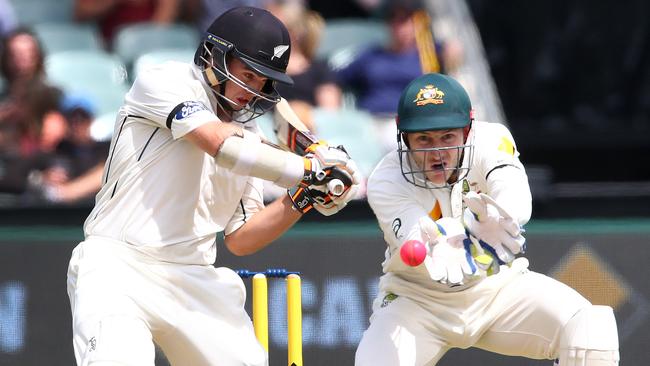A sense Test cricket made its historic transition as inevitably as night follows day, writes Richard Hinds
FOR 138 years Test cricket crowds dreaded the onset of darkness. On Friday, those at Adelaide Oval could hardly wait for night to fall, writes Richard Hinds.

Cricket
Don't miss out on the headlines from Cricket. Followed categories will be added to My News.
FOR 138 years observers of Test cricket had dreaded the onset of darkness as much as Count Dracula dreaded a torn curtain. Now, even as Australia dominated the daylight sessions of the first pink ball Test, the vast Adelaide Oval crowd could hardly wait for nightfall.
When the first artificially illuminated pink ball was bowled? The whole thing looked pretty much like Test cricket. Played with a pink ball. Under lights. At Trent Bridge.
The visibility was different. The beaten batsmen might say worse. But the conditions were not completely unfamiliar or particularly unfair.
Of course that is easily said if you were not the Kiwi tailenders who had been placed under sufficient pressure by a lacklustre top order without being forced to play crash Test dummy. Or – more pertinently – the Australian openers who came to the crease at 7.52pm when the nocturnal experiment went under the microscope.

In daylight Australia would have been in a dominant position having dismissed the Kiwis for 202. Now, with Kiwi seamers Tim Southee and Trent Boult making the ball duck and dart in the “awkward twilight period’’, the sense of apprehension was as palpable on the field as among the crowd of 47,441.
No doubt those doomsayers who feared this Test would be played with the sky falling, not merely darkening, will bemoan the sudden change of conditions from day to night. But that change seemed no less pronounced than when clear sky is replaced by heavy cloud and, it should be remembered, Southee and Boult are masters of swing.
Most pertinently the moving ball and even the clatter of wickets was refreshing after Perth where the ball beat bat three times in a day. Not three times in an over as Trent Boult beat David Warner before the Australian opener finally nicked off.
A game Australia might otherwise have dominated instead remained in the balance. Otherwise it was the format as much as the conditions that seemed a bit awkward after dark.
Night cricket had meant the helter-skelter of one day internationals and more recently T-20. So it was a touch disconcerting seeing batsmen defending their wickets with no compulsion to light it up when the venue had been.
In the two naturally illuminated sessions only the pink ball – and some awful shots by the Black Caps - distinguished the play from what might have been expected on a sporty but playable wicket.

Mitchell Starc bowled the first pink ball, a full-ish delivery squirted by Mark Latham to cover. But neither this, nor any of the other “firsts’’ were accumulated any differently than those in the “exclusively red-ball’’ era.
When it clouded over near the end of the first session the pink ball glowed even brighter. So when Kane Williamson shuffled back and was struck in front it was not as if the Kiwi batsman’s splendid form had been disrupted by some barely discernible novelty item.
It is important the integrity of Test cricket is safeguarded, but inevitable the success of the day-night Test will be measured at the gate. The crowd was the largest at an Adelaide Test since the Bodyline series of 1932/33 (50,962) when Harold Larwood turned the lights out.
Adelaideans are drawn to their beautifully renovated ground like Romans to the Colosseum. Add the novelty value and it would be misleading to declare day-night Tests a sure-fire hit elsewhere.
But the transition certainly did nothing to darken the crowd’s mood. If anything the buzz around the ground suggested Test cricket’s plunge into darkness was a moment of enlightenment.
Originally published as A sense Test cricket made its historic transition as inevitably as night follows day, writes Richard Hinds


